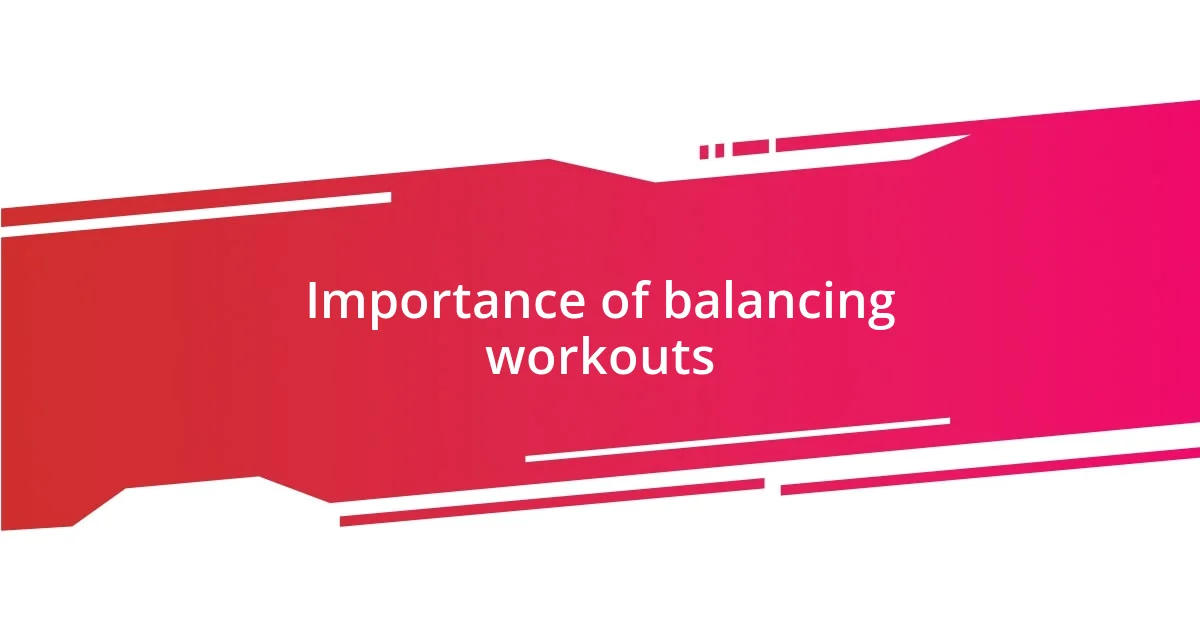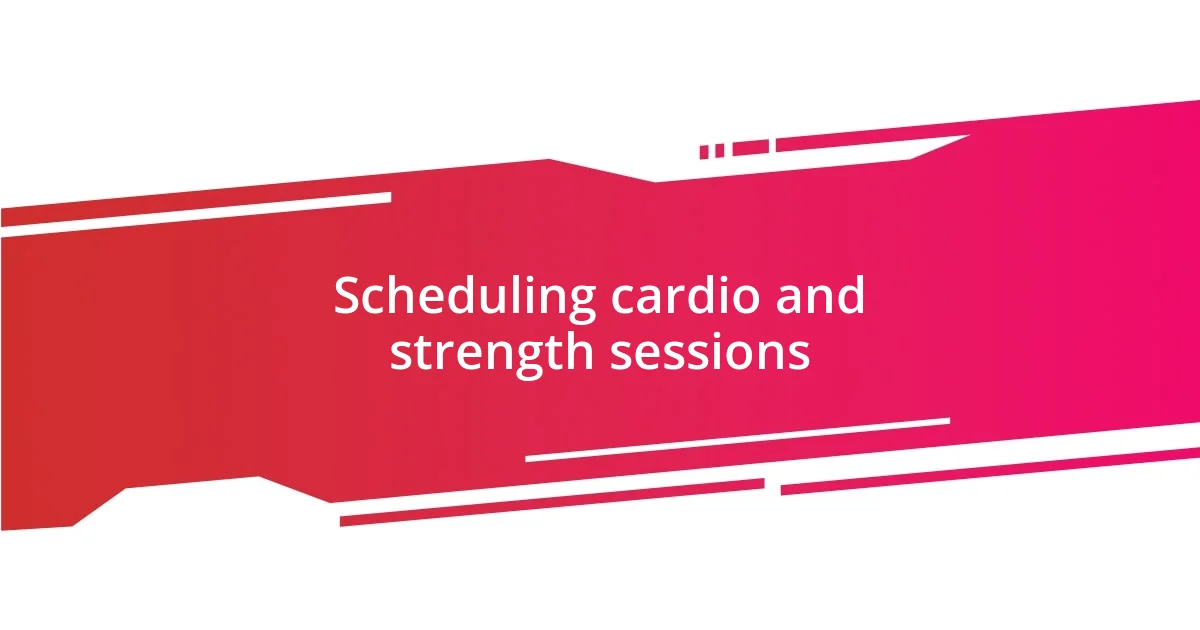Key takeaways:
- Balancing cardio and strength training is essential for enhancing performance, injury prevention, and maintaining motivation.
- Creating a structured workout plan and being flexible based on how your body feels improves enjoyment and sustainability in fitness routines.
- Tracking progress and adjusting workouts accordingly fosters continuous improvement and keeps the fitness journey engaging.

Understanding cardio and strength
Cardio and strength training serve different purposes but are complementary in a well-rounded fitness routine. Cardio, whether it’s running, cycling, or swimming, elevates your heart rate and improves your cardiovascular health. I remember when I first started running—feeling my heart pound in my chest was both exhilarating and terrifying, yet it pushed me to discover my limits.
On the other hand, strength training focuses on building muscle and enhancing overall strength. I can still picture the first time I completed a set of deadlifts; the sense of accomplishment lit a fire in me that made me want to lift heavier the next time. The contrast between the two forms of exercise often made me wonder: how can I effectively integrate both without feeling overwhelmed?
Finding the right balance depends on individual goals and preferences. For example, I’ve noticed that on days when I prioritize strength, I’m more energized and focused in my cardio sessions later in the week. Have you ever noticed how a solid strength workout can elevate your endurance during cardio workouts? This synergy reinforces my belief that understanding both aspects can lead to holistic fitness gains.

Importance of balancing workouts
Balancing cardio with strength training is crucial for optimizing performance and preventing burnout. When I first started my fitness journey, I often over-prioritized one over the other, resulting in fatigue and frustration. It wasn’t until I embraced a more balanced approach that I truly began to enjoy my workouts, feeling invigorated instead of drained.
Here are a few reasons why balancing these workouts matters:
- Injury Prevention: A balanced regimen strengthens different muscle groups, reducing the risk of overuse injuries.
- Enhanced Performance: Incorporating both types of training improves overall athletic performance, whether you’re lifting weights or running a marathon.
- Variety Keeps Motivation High: Mixing cardio with strength offers diversity, making workouts feel fresh and engaging.
- Metabolism Boost: Together, they can elevate your metabolic rate, helping with weight management and fat loss.
- Improved Recovery: Balance allows for active recovery, as the body benefits from different forms of stress and movement.
By integrating both cardio and strength into my routine, I’ve experienced not only physical improvements but also a mental lift that comes from knowing I’m taking care of my entire body.

Creating a balanced workout plan
Creating a balanced workout plan takes thoughtful consideration of your goals, time constraints, and personal preferences. I’ve found that initially mapping out my week with designated days for cardio and strength helped keep me on track. For instance, I’d schedule strength training on Mondays, Wednesdays, and Fridays, reserving the other days for cardio. This method not only guaranteed variety but also ensured that I was giving each type of workout the attention it deserved.
As I gained more experience, I started to adjust my approach based on how my body felt. Some weeks, I’d switch things up by including a high-intensity interval training (HIIT) session, which blends cardio and strength. That added an exhilarating challenge and made my workouts feel less monotonous, and it was rewarding to see my progress reflected in both my stamina and strength levels. Have you ever experienced that boost of confidence when you finally conquer a challenging workout?
In my journey, listening to my body’s cues has been a game changer. If I noticed fatigue creeping in, I’d take a break from strength work and focus more on cardio, or vice versa, depending on what felt right. This flexibility allowed me to enjoy my workouts rather than dreading them, reinforcing a more sustainable and healthy relationship with exercise.
| Aspect | Cardio | Strength Training |
|---|---|---|
| Primary Benefits | Improves cardiovascular health | Builds muscle mass and strength |
| Ideal Frequency | 3-5 times a week | 2-4 times a week |
| Workout Duration | 20-60 minutes | 30-90 minutes |
| Popular Types | Running, cycling, swimming | Weightlifting, resistance training |

Scheduling cardio and strength sessions
Finding the right balance between cardio and strength sessions often comes down to scheduling. Personally, I’ve found that setting a specific time for each workout helps me stick to my plan. For example, I often choose mornings for strength training when I have more energy, leaving the evenings for my cardio sessions. This not only energizes my day but also creates a sense of structure that keeps me accountable.
Over time, I’ve learned to be realistic about my available time for workouts. Mixing in shorter, high-energy seshes—like a quick 20-minute HIIT after a strength workout—has become a favorite tactic of mine. It’s crazy how that little burst of cardio can revitalize my routine without taking away too much from my strength goals. Have you ever tried squeezing in an extra challenge when you least expect it? It can be so rewarding!
Flexibility is key in my scheduling philosophy. If a strength day feels overwhelming, I give myself permission to dial it back and focus more on cardio instead. This way, I respect my body’s signals rather than forcing myself into a rigid schedule. I believe that this adaptability not only enhances my overall performance but also fosters a more enjoyable workout experience. What’s your approach when life gets busy? Remember, it’s perfectly okay to adjust and find what fits you best!

Choosing types of cardio activities
Choosing the right types of cardio activities can be quite the adventure. Personally, I’ve dabbled in everything from running to cycling to swimming, finding that each brings its unique flavor to my workouts. Running, for instance, has often offered me a meditative escape; there’s something liberating about hitting the pavement with my favorite playlist, feeling the rhythm of my feet against the ground. Have you ever found freedom in a simple run? It’s truly an experience worth exploring.
I also emphasize the importance of mixing intensity with enjoyment. For example, as much as I love long, steady-state runs, I’ve discovered that incorporating interval training—not just running but also cycling—keeps my heart racing and my mind engaged. Those short bursts of maximum effort followed by recovery have proved to be both fun and effective. What do you find more exhilarating: chasing distance or pushing your limits in shorter intervals?
While these activities bring excitement to my routine, it’s essential to consider how they fit my overall goals. If you’re aiming for fat loss or improved endurance, HIIT might be your best bet, but if you’re building stamina, longer sessions may be ideal. It’s all about aligning your cardio choices with what you wish to achieve. So, rather than sticking to one approach, why not take the plunge and experiment with different activities? You might just discover a new favorite!

Incorporating strength training techniques
Incorporating strength training techniques into my routine has transformed my approach to fitness. I often rely on compound movements such as squats and deadlifts, which engage multiple muscle groups simultaneously, creating a more efficient workout. I remember the first time I added kettlebell swings to my regimen—after just a few sets, I felt an exhilarating rush of energy that made me realize how effective integrating those dynamic movements can be. Have you ever had an exercise you underestimated turn out to be a game changer?
I also prioritize progressive overload, which simply means gradually increasing the weight or resistance in my strength sessions. I found that when I focused on small, incremental changes, I not only built strength more effectively but also kept myself motivated. It’s rewarding to see those tiny gains add up over time. Ever noticed how a seemingly slight increase in weight can boost your confidence the next time you hit the gym?
Another essential technique I’ve embraced is the inclusion of supersets—an approach where I perform two exercises back-to-back with little to no rest in between. This method keeps my heart rate high while still focusing on those important strength-building exercises. I recall a particularly taxing workout where I alternated between push-ups and rows; the burn was intense, yet I felt accomplished by the end. Isn’t it fascinating how mixing up your routine can lead to surprising breakthroughs?

Tracking progress and adjusting plans
Tracking progress in my fitness journey has always been a crucial part of achieving my goals. I remember the first time I started using a fitness app to log my workouts—seeing those numbers add up was not just motivating, it also gave me a clear picture of what was working. Have you ever felt that thrill when you hit a new personal best? Writing down my progress encouraged me to push further, knowing I had tangible evidence of my hard work.
Adjusting my plans based on my progress is essential. For instance, after a few weeks of consistent running, I noticed my stamina improving significantly. It was exhilarating, but it also prompted me to tweak my training regime by adding more challenging intervals. This flexibility, I’ve learned, is key in staying engaged and continuing to make progress. It’s like dancing with your fitness routine—sometimes you need to change steps to keep it fresh and exciting!
I also find it helpful to reflect on how I feel after a workout. There were days when I pushed myself too hard and ended up feeling drained instead of accomplished. Those moments taught me that listening to my body is just as important as tracking speeds or weights. Have you ever had the experience of knowing when to pull back? Balancing challenge with recovery is a delicate dance, but it’s what fosters long-term growth and keeps my passion for fitness alive.













